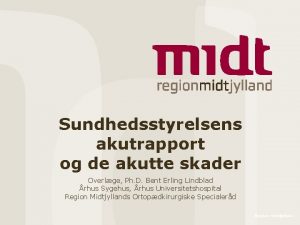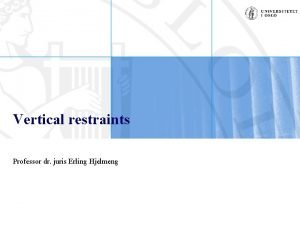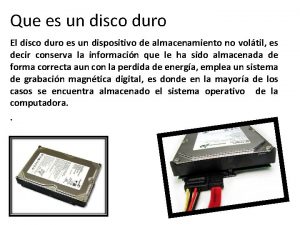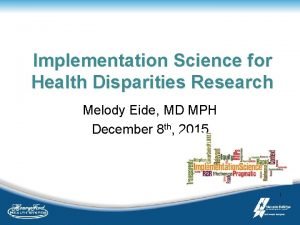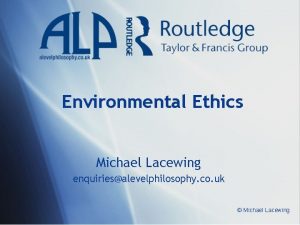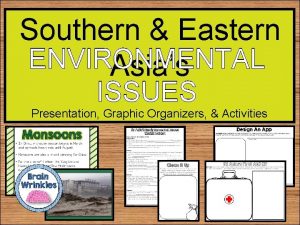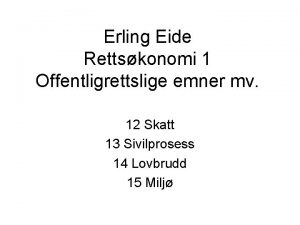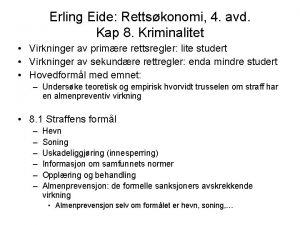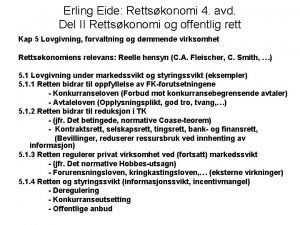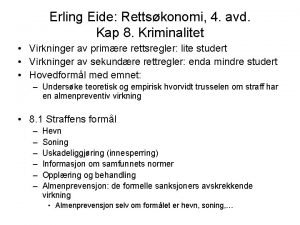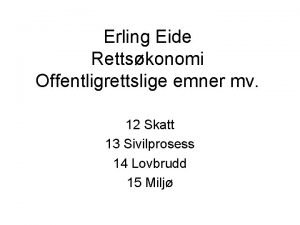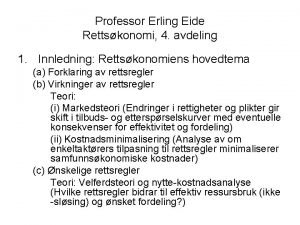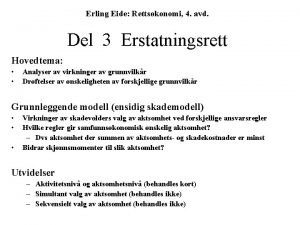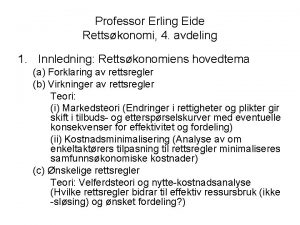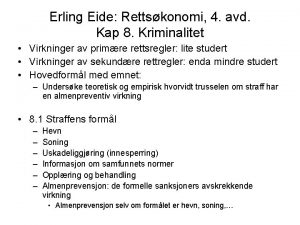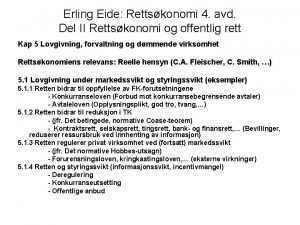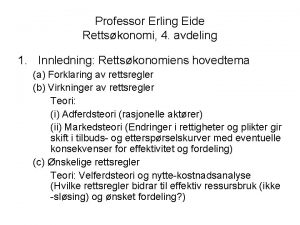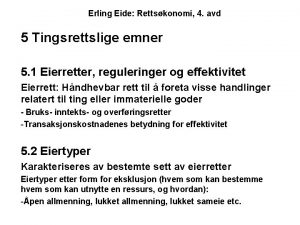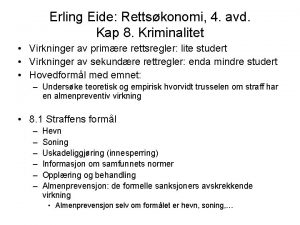Erling Eide ELE Day 2 2 Environmental issues














- Slides: 14

Erling Eide, ELE Day 2 2 Environmental issues (problems and goals) • 2. 1 Examples of what might be thought to be a problem • 2. 2 What is the problem? • 2. 3 Goal analysis: Modeling priorities and policy choices U/ELE/H 13 day 2. ptt 1

2. 1 Examples of what might be thought to be a problem • Environmental services – Purification services (Nature as a purification plant) – Recreation services – Extraction of resources (animals, minerals, …) • Problems – Degradation/reduction in these services • Long list of what people consider as problems – Pollution damage – Damaged recreational services – Depletion of natural resources U/ELE/H 13 day 2 rev 3. ptt 2

2. 1 (cont. ) • Exhaustable resources (minerals, gas, oil, species…) – Depletion • Non exhaustable resources (fish stocks, pastures, forests, clean atmosphere, clean rivers, …) – Overuse, reduction of stocks, pollution… • STOP IT? – Pollution causes health problems. Stop it? – Waste causes degraded recreational services. Stop it? – Extraction of minerals reduces stock available to future generations. Stop it? • Stop it at which level of depletion/degradation? U/ELE/H 13 day 2 rev 3. ptt 3

2. 2 What is the problem? Externalities • Decision makers’ behaviour: – Decision makers do not take into account the negative effect on others of their activity. • Damage costs to others (negative externalities) not included when producers and consumers are balancing benefits vs. costs. • In market equilibrium consumers pay for the scarce resources used in production (at the margin), -- but not for the external effects. • Products too cheap. • Production too high. U/ELE/H 13 day 2 rev 3. ptt 4

Example: The tragedy of the commons • Definition of commons: – Resource that anybody can extract or use – Resource rent: The surplus value after all costs of extraction or use, and normal returns, have been accounted for. – The gift of nature – Competition to get hold of the gift – (Model) consequence: The tragedy of the commons: Resources depleted • Examples of commons – Fish stocks in oceans (whales, cod, …) – Pastures – Atmosphere U/ELE/H 13 day 2 rev 3. ptt 5

2. 3 Goal analysis: Modelling priorities and policy choices • Alternative goals: – Welfare based optimal emissions – Other standards of emissions • 2. 3. 1 Optimal production: See section 1. 5 U/ELE/H 13 day 2 rev 3. ptt 6

2. 3. 2 Optimal amount of emissions -Emissions given level of production • Example: Pollution of a given activity (Production in a given plant is held constant) • Costs of pollution: – Reduced environmental quality • requires purification measures in adjacent plant • Causes health problems • Reduces recreation services in the neighborhood • Costs of reducing pollution – – Higher quality of inputs More air cleaners Increased quality control of production U/ELE/H 13 day 2 rev 3. ptt … 7

2. 3. 2 (cont. ) Goal: Minimisation of total costs COSTS TOTAL COSTS DAMAGE COSTS ABATEMENT COSTS EMISSIONS FIG. 2. 1 Determination of optimal emissions U/ELE/H 13 day 2 rev 3. ptt 8

2. 3 (cont. ) Goal: Minimisation of total costs MARGINAL COSTS MARGINAL DAMAGE COSTS MDC=MAC MARGINAL ABATEMENT COSTS EMISSIONS FIG. 2. 2 MARGINAL COSTS AND OPTIMAL EMISSIONS U/ELE/H 13 day 2 rev 3. ptt 9

COSTS TOTAL COSTS DAMAGE COSTS ABATEMENT COSTS EMISSIONS MARGINAL COSTS MDC=MAC MDC MAC U/ELE/H 13 day 2 rev 3. ptt EMISSIONS 10

Internalizing Externalities • Allocation of ownership rights (property rights): – To the polluter • Contract on pollution reduction (”laissez-faire rule”) – To the damaged party • Contract on pollution increase (”polluter rule”) • Transferability of ownership rights • Allocation and transferability of ownership rights makes externalities into a marketable good. – The government set the rules – Actors act. U/ELE/H 13 day 2 rev 3. ptt 11

COSTS TOTAL COSTS DAMAGE COSTS ABATEMENT COSTS EMISSIONS MARGINAL COSTS MDC=MAC MDC MAC U/ELE/H 13 day 2 rev 3. ptt EMISSIONS 12

2. 3 (cont. ) Internalisation of costs MARGINAL COSTS MARGINAL DAMAGE COSTS MDC=MAC MARGINAL ABATEMENT COSTS Elow FIG. 2. 2 MARGINAL COSTS AND OPTIMAL EMISSIONS U/ELE/H 13 day 2 rev 3. ptt Ehigh EMISSIONS 13

Internalizing Externalities (cont. ) • Environmental liability • Pigouvian taxes • Regulations U/ELE/H 13 day 2 rev 3. ptt 14
 Hvad er målrettet kommunikation
Hvad er målrettet kommunikation Day 1 day 2 day 3 day 4
Day 1 day 2 day 3 day 4 Bent erling lindblad
Bent erling lindblad S
S Erling roland
Erling roland Björn erling evensen
Björn erling evensen Erling hjelmeng
Erling hjelmeng Day 1 day 2 day 817
Day 1 day 2 day 817 Una unidad eide de gran velocidad
Una unidad eide de gran velocidad Cfir
Cfir Jill eide
Jill eide Helge eide ks
Helge eide ks Explain how dishes on a menu address environmental issues
Explain how dishes on a menu address environmental issues Environmental ethics issues
Environmental ethics issues Environmental issues graphic organizer
Environmental issues graphic organizer


